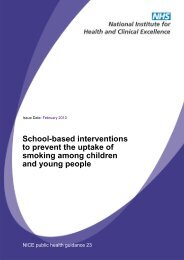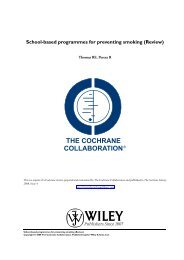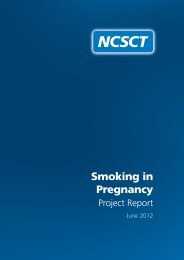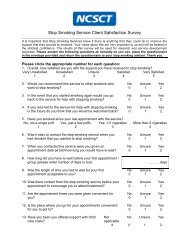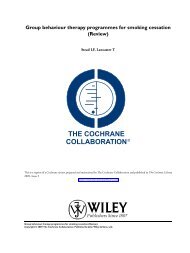Smoking and mental health - NCSCT
Smoking and mental health - NCSCT
Smoking and mental health - NCSCT
You also want an ePaper? Increase the reach of your titles
YUMPU automatically turns print PDFs into web optimized ePapers that Google loves.
<strong>Smoking</strong> <strong>and</strong> <strong>mental</strong> <strong>health</strong><br />
<strong>mental</strong> illnesses (because the characteristics between these two groups are<br />
probably more similar than between those with schizophrenia <strong>and</strong> the general<br />
population); the combined estimates were 2.3 (95% CI 2.0–2.7, 14 studies) <strong>and</strong><br />
1.8 (95% CI 1.5–2.3, 8 studies) for males <strong>and</strong> females, respectively.<br />
4.7 <strong>Smoking</strong> <strong>and</strong> anxiety disorders<br />
Table A4 summarises the main design features <strong>and</strong> findings from 18 prospective<br />
studies identified from the literature search. Due to the different methods of<br />
assessments <strong>and</strong> definitions of exposures <strong>and</strong> outcome measures, a formal metaanalysis<br />
was not performed.<br />
Eleven studies investigated whether people with anxiety disorders were more<br />
likely either to be smokers or to take up smoking. 21,23,24,38–45 Of these, five<br />
reported clear positive associations, 23,38–41 five found non-significant positive<br />
correlations 21,24,42–44 <strong>and</strong> one 45 found a decreased risk. Of studies of the uptake<br />
of smoking in relation to anxiety at baseline, 21,24,39–41 two found strong increases<br />
in risk (OR = 3.85, 95% CI 1.34–11.0 39 <strong>and</strong> OR = 1.9, 95% CI 1.3–2.8 41 ) whereas<br />
three found modest or non-significant associations. 21,24,40<br />
Eight studies examined whether smokers at baseline were more likely to<br />
develop anxiety disorders later. 3,26,43,46–50 Five of these were based on teenagers<br />
<strong>and</strong> three on adults (18–64 years). ORs for onset of anxiety were increased in six<br />
of the studies that reported effect sizes: 5.53 (95% CI 1.84–16.66), 50 1.88 (95%<br />
CI 1.15–3.06), 3 1.46 (95% CI 1.15–1.86), 49 3.23 (95% CI 1.0–10.8) 46 <strong>and</strong> 2.32<br />
(95% CI 1.19–4.53). 47 Increased risks were also seen in the two studies of effect<br />
of smoking on post-traumatic stress disorder: 5.1 (95% CI 1.2–21.5) 48 <strong>and</strong> 2.64<br />
(95% CI 1.05–6.62). 47 One study reported a positive regression coefficient<br />
between baseline smoking status <strong>and</strong> subsequent anxiety score. 43 Only one study<br />
reported a reduced risk associated with daily smoking; however, this effect was<br />
not statistically significant (RR = 0.9, p = 0.8). 26<br />
4.8 <strong>Smoking</strong> <strong>and</strong> eating disorders<br />
Three prospective cohort studies of the association between eating disorders <strong>and</strong><br />
the onset of smoking were identified 51–53 (see Table A5), all involving 1 year of<br />
follow-up in adolescents aged 11–15 years at baseline. In one of the studies,<br />
binge eating or purging was not significantly related to smoking uptake in males<br />
(OR = 0.7, 95% CI 0.1–4.1) or females (binge eating: OR = 1.8, 95% CI 0.9–3.5;<br />
purging: OR = 2.0, 95% CI 0.8–4.9). 51 However, in the other two studies, the<br />
risk of onset of smoking was found to be significantly associated with body<br />
dissatisfaction <strong>and</strong>/or eating pathology (OR = 4.33, 95% CI 1.71–10.95), 52 <strong>and</strong><br />
in those with a high eating disorder symptom score in girls (OR = 2.15, 95% CI<br />
1.16–3.97) but not in boys (OR = 1.67, 95% CI 0.91–3.07). 53 One of the<br />
70 © Royal College of Physicians 2013




